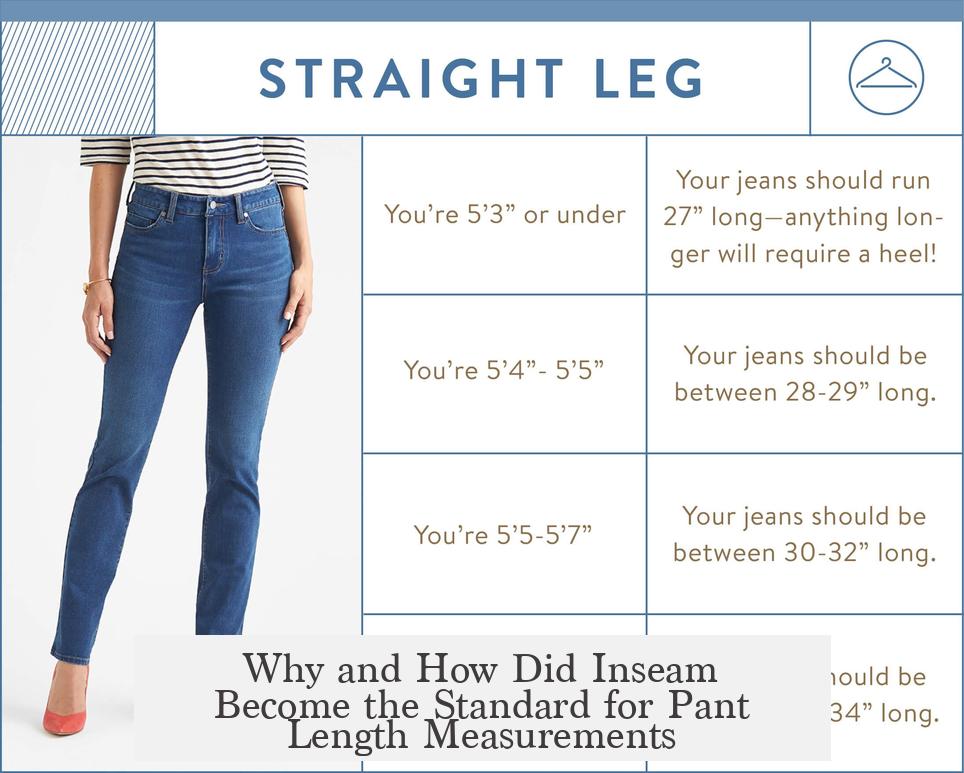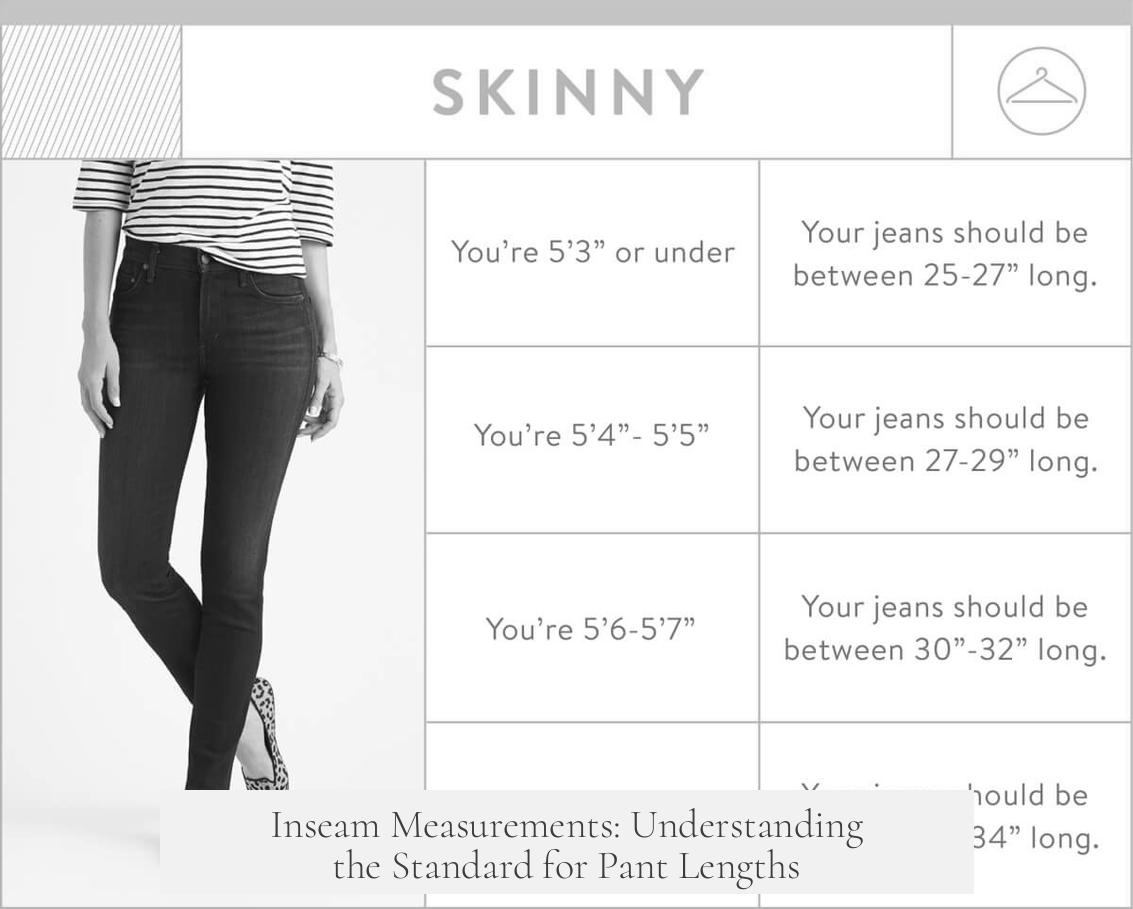The inseam became the standard for pant length measurements because it offers a consistent, straightforward way to gauge leg length that works across different pant styles and waist placements. Unlike other measurements, such as the outseam or crotch length, inseam focuses strictly on the leg portion, making it less variable and easier to standardize for both tailoring and mass production.
Understanding why inseam measurement is preferred requires a comparison with other common pant measurements. The inseam measures the length from the crotch point to the hem of the pants. It represents the leg length, which remains relatively consistent across varying styles of pants.
On the other hand, the crotch measurement describes the length of the crotch seam. This measurement affects how high the waistband sits, commonly referred to as the “rise.” Because waistbands sit differently depending on pant style (low-rise, high-rise, etc.), crotch measurements vary significantly.
The outseam measures the entire length along the outer edge of the pants, from the waist to the hem. This includes both the torso length and leg length combined. The outseam thus varies widely depending on where the waistband is placed and how the pants are styled—such as mid-rise versus low-rise or skinny versus boot-cut pants.
This variability causes major challenges for standardization. If only the outseam was used as a guide, consumers would need detailed knowledge of each pant style’s waist placement to select the correct size. They might also have to try on multiple sizes to find the correct length, increasing complexity.
Historically, tailors required multiple measurements to properly fit or alter pants, including waist, hip, knee, ankle, crotch, inseam, and outseam. Among these, the inseam provided a reliable leg length measurement that was relatively unaffected by torso measurements or styles. Tailors could then separately account for the waist and torso fit.
For mass production, this consistency was essential. Factories needed one dependable measure for the leg length to produce pants efficiently. Measuring inseam simplifies production because manufacturers do not have to adjust for variations in how high or low pants sit on the waist within a given inseam length.
The shift in pant styles over time further clarified the inseam’s usefulness. Modern pants are often much lower waisted compared to those from 50 or 100 years ago. For example, dress pants designed to be worn with tailcoats maintain a higher waist, affecting the outseam significantly.
Because the outseam changes with waist placement and style, it cannot serve as a universal standard. The inseam, however, measures only from the crotch to the bottom of the leg, a length that does not change with the rise or bagginess of the pants. Therefore, inseam remains constant across styles like boot-cut, skinny, flare, and low-rise.
To illustrate, consider a pair of low-rise jeans and high-rise dress pants. Though the outseam measurement differs dramatically due to waist placement, both may share the same inseam length if they fit the wearer’s leg length equally well.
| Measurement | Definition | Variability | Relevance to Standardization |
|---|---|---|---|
| Inseam | From crotch to hem (leg length) | Low; consistent across styles | Highly relevant; primary standard for length |
| Crotch | Length of crotch seam (waistband rise) | High; varies with style and fit | Less relevant for length standardization |
| Outseam | From waist to hem (torso + leg length) | Very high; depends on waist placement and style | Complicates mass production and sizing |
In practical terms, the inseam allows consumers and manufacturers to focus on a measurable, repeatable standard for leg length. When buying or altering pants, knowing the inseam helps find the right leg length without worrying about how the waist fits or where it is positioned. This reduces trial and error or reliance on style-specific knowledge.
Mass production benefits from this measurement choice as well. It creates a baseline for sizing charts that work across various pant designs. While waist size, rise, and cut remain separate variables, the inseam ensures that pants will fit leg length appropriately regardless.
In summary, the inseam became the standard measurement for pant length due to its precision, consistency, and practical suitability in both tailoring and mass manufacturing contexts. Its independence from waist height makes it a reliable standard in an industry with diverse styles and fits.
- The inseam measures leg length from crotch to hem, remaining consistent across styles.
- Outseam varies greatly due to waist placement and pant style, complicating sizing.
- Tailors historically needed multiple measurements, but inseam proved a stable standard.
- Mass production favors inseam for reliable, easy sizing across styles.
- Modern style variations in waist height underscore inseam’s consistency.
Why and How Did Inseam Become the Standard for Pant Length Measurements?

The inseam became the standard for pant length measurements because it reliably reflects leg length from crotch to hem, which remains consistent across different styles and waist placements. This makes it easier for manufacturers, retailers, and consumers to find pants that fit the leg length properly without endlessly guessing how the pant’s style affects fit.
Let’s unpack this and explore the story of the inseam’s rise to measurement fame. Hang tight; this isn’t just a boring numbers game—it’s a practical, historical showdown between inseam, outseam, and crotch measurements.
Inseam vs Crotch vs Outseam: What’s the Difference?
The inseam measures the length from the crotch—the point where the legs join the body—to the hem of the pant leg. This is straightforward: it basically captures your leg’s length, untouched by the wild world of style variations.
Now, the crotch measurement isn’t about length but seam. It tracks how long the crotch seam is, which impacts how high or low the waistband sits on your waist—also known as the rise. This varies a lot depending on a pant style. Ever heard of “low-rise” or “high-rise” jeans? There’s your crotch measurement in action.
Then there’s the outseam. It stretches from the waistline all the way down to the pant leg’s hem. At first glance, this seems like a good way to measure pant length. But there’s a catch: the waistline height changes. Some pants sit high; others slap lower on your hips. Also, baggy versus slim fit throws off this length. In other words, the outseam measurement can be as unpredictable as the latest fashion trend.
Why Tailors and Manufacturers Prefer the Inseam
Historically, tailors measured tons of things to craft perfectly fitting pants—waist, hip, knee, ankle, and yes, both inseam and outseam. But outseam was a headache to standardize.
Imagine trying to make an entire line of pants using the outseam for length. You’d have to guess where each person wants their waistband. One person prefers their pants riding high; another likes them low. The outseam measurement changes with these preferences. How does a factory make millions of pairs work?
“If I was to take this pattern and try to standardize it, we would define how the leg fits and how the torso fits separately (ex. boot-cut, low-rise) based on our company’s ‘average’ person’s measurements. Both parts can be adjusted, but the outseam varies based on both.” — Tailoring Expert
Mass production demanded a clear, consistent, and simple measurement. The inseam fits that bill perfectly because it isolates leg length from waist height variations. This means factories and retailers could easily size pants by leg length alone, leaving the waist and rise to be adjusted independently—much simpler and less error-prone.
Modern Styles and Waist Placement: Why Outseam Trips Up
Fashion evolution gave us pants sitting lower on the hips than 50 or 100 years ago. Think about how today’s jeans often wear below the belly button, compared to traditional dress pants.
This shift messes with outseam measurements—a pair of low-waisted jeans and high-waisted trousers can have hugely different outseam lengths even if your leg length stays the same.
Inseam isn’t fooled by styles. No matter what pop culture dictates, the distance from crotch to hem remains fairly steady. So it stays a reliable guide through the maze of modern pant styles.
Practical Benefits of Using Inseam

- Consistency: Inseam is stable across styles, rise heights, and fits.
- Ease of Finding Suitable Pants: Shoppers can trust inseam to figure out leg length. Even if other fit factors fail, pants with the right inseam won’t drown or trip you.
- Mass Production Friendly: Factories can produce standard inseam lengths without worrying about waist placement variability.
- Altering Made Simple: Tailors frequently adjust length at the hem, matching the inseam. It aligns perfectly with their workflow.
Imagine trying to guess if a pant with an outseam of 40 inches fits you. That single number tells you nothing without knowing the waist height. A low-rise pant could have the same outseam as a high-rise pant but drastically different on you.
Real-World Example: Why Inseam Wins Every Time
Picture picking pants online. You’re browsing through dozens of styles. The inseam listed might be 32 inches. That means if your leg length measures 32, the pants will likely fit your leg length correctly. Easy, right?
Now imagine the site gives only outseam measurements. You’d have to know exactly where the pants sit on the waist, how the rise affects measurements, and guess if your torso size matches. It’s a complicated puzzle most shoppers don’t want to solve.
Thanks to the inseam’s simplicity, you just need a tape measure, some basic knowledge, and you’re set to find pants that fit your legs. No more returns or half-lit attempts at approximations.
Wrapping It Up: Why Inseam Became King
In a world full of pant styles, from baggy cargo to sleek boot-cut, measuring leg length consistently is key. The inseam offers a standardized measurement independent of waistband height or pant style.
This has historic roots in tailoring practices but gained massive importance with mass production and consumer shopping convenience. The inseam became the standard because it isolates one crucial factor—leg length—without getting tangled in the style and rise variations.
So next time you see inseam listed on a pair of pants, remember: it’s not just a random number slapped on there. It’s the tailor’s secret weapon turned manufacturing marvel, helping millions find pants that don’t trip them up (literally).
Are you checking your inseam or outseam next time pants shopping? Probably inseam—because in this game, simplicity wins.



